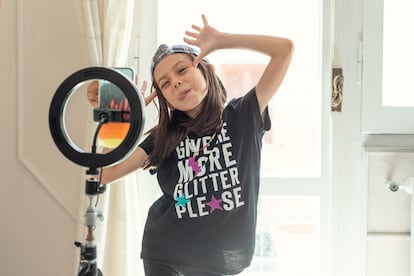‘We cannot normalize having 10-year-old children working as influencers’: The challenge of controlling underage content creators
Members of the Alpha generation are garnering millions of views on social media. We spoke with experts about the potential consequences of this overexposure

Some of the influencer children of the Alpha generation — those born after 2010 — have more millions in the bank than years of age. They have acquired world fame on platforms like TikTok because they speak, make themselves up and dance just like the influencers they have been mimicking all of their lives. One recent example are the so-called Sephora Kids: this trend has filled the social networks with videos featuring hundreds of 10-year-old girls who get their hands on as many of the brand’s makeup products as they can to do skin care routines for their followers.
Garza Crew’s TikTok account has 4.9 million followers. The videos, made by her mother, show her as a 7-year-old American girl who, baby teeth and all, presents her makeup routines and the products that she buys like a professional. She also takes the time to talk about what it means to be a Gen Alpha influencer: “Of course we are obsessed with skin care. Of course our favorite stores are Sephora and Ulta. Of course we don’t have toys.” The star of the Garza Crew videos claims that she has been buying makeup with her sister, who is the same age, since they were both six years old. All her videos are monetized.
In September, Forbes magazine published the ranking of last year’s top creators, “the social media stars turning followers into fortunes.” On that list stands out 9-year-old Ryan Kaji, who went viral reviewing toys. Thanks to his 36 million followers, he made $35 million in 2023. His family has turned his online influence into a company called Ryan’s World that sells toys, board games and clothing, and he has already surpassed social media queens like Chiara Ferragni and Monet McMichael.
@garzacrew Her happy place 🙌🏼🙌🏼
♬ original sound - layla’s mother
Cintia López Narváez, 36, has been a content creator for 12 years. This Spanish influencer first started with a fashion blog before migrating to Instagram, where she showed the outfits she wore to work. However, after her children were born, she decided to change her strategy: now her account revolves around motherhood and children. “I’m doing much better with this type of content; my community has grown a lot,” she says. Her six-year-old son Jorge has starred in campaigns for brands with her since before he can even remember.
López assures that he does it of his own free will. “First I ask him if he feels like doing it, and we always do it as if it were a game.” She has already lost count of all the brands she has worked with, but she does remember that everything, from the diapers to the children’s room, were collaborations.
The son has learned from the mother by imitation, and is already making videos of himself mimicking what he has heard her say thousands of times: “Follow, like, and don’t forget to activate the notifications.” López believes that soon Jorge will have his own content creator account — and she is fine with that. “For them it is normal, because they have been in contact with social media all their lives. We had to learn it.”
According to the study Generation Alpha: The Real Picture, published by GWI, in the United States the Alpha generation has influence and purchasing power beyond their age. “Around a third of teens have a bank account they can access,” states the report. In it, the researchers conclude that these children also have a higher social awareness from an early age and that they will become consumers of big brands earlier.
It is all the result of many, many hours of screen time. “Without a doubt, it is the youngest who spend the most hours glued to the screens, which in some way end up educating the children,” says psychologist Silvia Álava, author of the book Queremos hijos felices (in English: We want happy children). “The people that children follow on social media often show unattainable realities with which they compare themselves: the body, luxuries and diet could be affected by overexposure to social media in an unhealthy way.”
The problem is linking happiness to that idealized physical image, as that only leads to frustration. Facebook research leaked in 2021 showed that social media influences the mood of young people: more than 40% of Instagram users said they did not feel attractive while using the app.
Psychologist Lorena González, CEO of Serena Psicología, a clinic that focuses on women’s well-being in Madrid, Spain, sees how mothers come to her office every day worried about their children and social networks. “We have many examples of children who were famous at a very young age starring in films, and we have been able to see how at that age they don’t understand that the reinforcement that fame provides is not real, and that having millions of followers is nothing definitive. The broken toy syndrome is now being transferred to young influencers who live for their likes,” says the expert. Her opinion on the new phenomenon is emphatic: “We cannot normalize having 10-year-old children working as influencers. It should be penalized.”
The phenomenon did not spring up out of nowhere. The children of the Alpha generation, explain the experts consulted, have internalized what they have been taught since they were in the wombs of their millennial mothers, who have exhibited their children’s lives on their social media accounts from the day there were born. “Children learn what we teach them. We are their role models. If parents normalize this online overexposure, then this will be normal for them, although we still do not know the consequences,” says González. Sheila Tabernero, 42, runs the Instagram account Palabra de madre (in English: Mother’s word), which has 58,300 followers and focuses on family leisure activities. She started in 2012 when she became pregnant with her first child, doing a blog about her experience with motherhood. Little by little she evolved, and when the second child arrived she began to talk not only about pregnancy, but also about issues of being mothers and family. “I entered this world of content creators and brands began to contact me, and that’s when my whole family and I began to collaborate,” says Tabernero, who is represented by the influencer agency SP Talents.
Tabernero explains that her three children have appeared on her social media accounts since they were born. “For them it is normal. As they have grown, especially with the eldest, who is 11, I have tried to be increasingly careful with their image,” she says. Although most of her videos are about family trips, where they appear in very natural situations, she does ask for her children’s input. “I always ask them before posting if they agree with the content they are going to appear in. In my house, my children fight because they want to be in my videos and collaborate with brands. If it were up to my oldest son, Ares, he would have gotten his own YouTube channel a couple of years ago, but I still don’t want him to,” she points out.
For psychologist María Padilla, this generation will usher in a paradigm shift: “It’s a generation that lives in a world dominated by digital technologies. These are children who have never known a world without the internet, smartphones and tablets.”
Social media expert José Alvargonzález resorts to the data to explain the situation: “TikTok has experienced exponential growth among young users. Recent statistics indicate that a considerable percentage of its user base is made up of children under 16, who spend on average a significant amount of time on the platform each day.” Hence the cost: “It is key to consider the impact of social media on child development. These platforms can foster creativity, personal expression and communication skills in children, but on the other hand, there are associated risks such as exposure to inappropriate content, self-esteem problems and pressure to maintain an idealized public image.”
In this context, the lack of labor regulation of content made on social networks by minors and the poor compliance with existing guidelines means that these children can spend hours making monetized videos: “If these same 10-year-olds were working as waiters instead of influencers, they would be immediately penalized,” says the expert.
The Spanish National Cybersecurity Institute points out that the parents must also make sure that their children avoid personalized advertising on social media. They must set up the “ad configuration of the main social networks and use the options to report or denounce those advertisements that do not seem appropriate. Furthermore, it is very important that minors do not share personal information without the advice of a responsible adult, even if it seems like a trivial giveaway,” something very common on Instagram and TikTok. In addition, they see it as essential to “limit screen time in order to reduce the number of hours in which they will find advertising, therefore reducing the amount of commercial content that they will consume.”
Sign up for our weekly newsletter to get more English-language news coverage from EL PAÍS USA Edition
Tu suscripción se está usando en otro dispositivo
¿Quieres añadir otro usuario a tu suscripción?
Si continúas leyendo en este dispositivo, no se podrá leer en el otro.
FlechaTu suscripción se está usando en otro dispositivo y solo puedes acceder a EL PAÍS desde un dispositivo a la vez.
Si quieres compartir tu cuenta, cambia tu suscripción a la modalidad Premium, así podrás añadir otro usuario. Cada uno accederá con su propia cuenta de email, lo que os permitirá personalizar vuestra experiencia en EL PAÍS.
¿Tienes una suscripción de empresa? Accede aquí para contratar más cuentas.
En el caso de no saber quién está usando tu cuenta, te recomendamos cambiar tu contraseña aquí.
Si decides continuar compartiendo tu cuenta, este mensaje se mostrará en tu dispositivo y en el de la otra persona que está usando tu cuenta de forma indefinida, afectando a tu experiencia de lectura. Puedes consultar aquí los términos y condiciones de la suscripción digital.
More information
Archived In
Últimas noticias
Not all insomnia is the same: Study identifies five subtypes and paves the way for personalized treatment
The United States designates Clan de Golfo as a foreign terrorist group
The United States strikes three more suspected drug boats, killing eight
The Iberian Peninsula is rotating clockwise, scientists report
Most viewed
- ‘El Limones’ and the growing union disguise of Mexican organized crime
- Christian Louboutin: ‘Young people don’t want to be like their parents. And if their parents wear sneakers, they’re going to look for something else’
- ‘We are dying’: Cuba sinks into a health crisis amid medicine shortages and misdiagnosis
- A mountaineer, accused of manslaughter for the death of his partner during a climb: He silenced his phone and refused a helicopter rescue
- The low-cost creative revolution: How technology is making art accessible to everyone











































